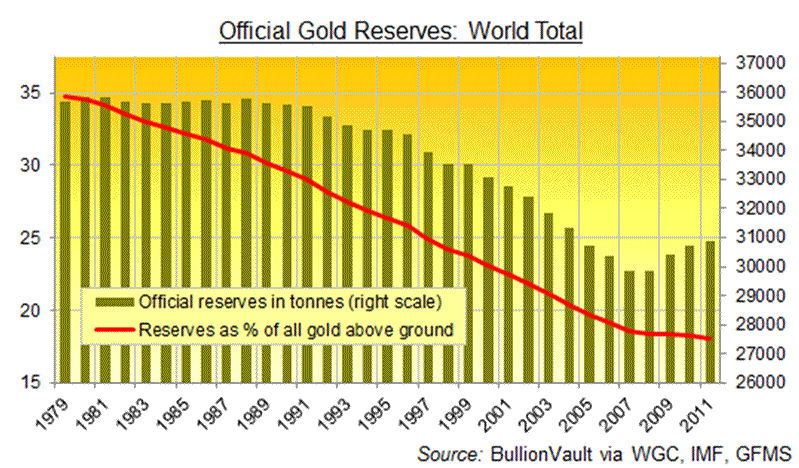"Yes, central banks are holding more gold. But they're holding very much more wood-pulp on top...
THE GOLD PRICE on Wednesday broke up through the downtrend starting at last summer's record high. Or so a technical analyst studying the price chart would tell you.
But just as in late 2007 – from where gold began a 55% run inside 6 months – this week the price of gold bullion jumped on news that is fundamental: the price of money, specifically Dollars, the world's #1 currency for trade and central-bank reserves.
Back in 2007, the catalyst came as a baby-step rate cut of 0.25%, signaling the Fed's switch from raising to destroying the returns paid on cash savings. Now the Fed's new zero-rate promise "took gold comfortably clear of the 50, 100 and 200-day moving averages, and opened up some big targets to the upside," says one London technician. The previous ceiling of $1700 has become a support level according to bullion bank Scotia Mocatta, "with further key support at the 200-day moving average at $1645."
Whatever you make of such numbers, it's worth stepping back to see the wood for the trees. Because the trend in who's buying gold, and why, is so plain to spot that you hardly need join the dots.
Gold bullion holdings amongst the world's central banks, for instance, have risen to a 6-year high, according to data compiled by the International Monetary Fund. Emerging and developing nations have swollen their gold reserves 25% by weight since 2008. The debt-heavy West is a net seller, but only just.

"There's a perception perhaps that gold is no longer a crucial part of the financial system in the way that it was under the Gold Standard before 1970, 1971," as Marcus Grubb of the World Gold Council put it in an interview with Tekoa Da Silva this week. "But in fact that's not really true.
"Because even with the ending of the Gold Standard, gold remains as an asset held by the world's central banks...and you've seen a trend recently for gold to become more and more a part of the fabric of the financial system."
at http://www.marketoracle.co.uk/Article32852.html
THE GOLD PRICE on Wednesday broke up through the downtrend starting at last summer's record high. Or so a technical analyst studying the price chart would tell you.
But just as in late 2007 – from where gold began a 55% run inside 6 months – this week the price of gold bullion jumped on news that is fundamental: the price of money, specifically Dollars, the world's #1 currency for trade and central-bank reserves.
Back in 2007, the catalyst came as a baby-step rate cut of 0.25%, signaling the Fed's switch from raising to destroying the returns paid on cash savings. Now the Fed's new zero-rate promise "took gold comfortably clear of the 50, 100 and 200-day moving averages, and opened up some big targets to the upside," says one London technician. The previous ceiling of $1700 has become a support level according to bullion bank Scotia Mocatta, "with further key support at the 200-day moving average at $1645."
Whatever you make of such numbers, it's worth stepping back to see the wood for the trees. Because the trend in who's buying gold, and why, is so plain to spot that you hardly need join the dots.
Gold bullion holdings amongst the world's central banks, for instance, have risen to a 6-year high, according to data compiled by the International Monetary Fund. Emerging and developing nations have swollen their gold reserves 25% by weight since 2008. The debt-heavy West is a net seller, but only just.

"There's a perception perhaps that gold is no longer a crucial part of the financial system in the way that it was under the Gold Standard before 1970, 1971," as Marcus Grubb of the World Gold Council put it in an interview with Tekoa Da Silva this week. "But in fact that's not really true.
"Because even with the ending of the Gold Standard, gold remains as an asset held by the world's central banks...and you've seen a trend recently for gold to become more and more a part of the fabric of the financial system."
at http://www.marketoracle.co.uk/Article32852.html